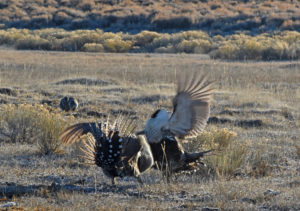For Immediate Release
September 8, 2022
Contact:
Shannon Anderson, Staff Attorney, Powder River Basin Resource Council, (307) 763-0995
Erik Molvar, Executive Director, Western Watersheds Project, (307) 399-7910
Sarah Stellberg, Staff Attorney, Advocates for the West, (208) 342-7024 x209
5,000-well project to harm air quality, sage grouse, raptor populations
WASHINGTON, D.C. – Conservation groups have filed a legal challenge targeting the Converse County Oil & Gas Project in the southern Powder River Basin of Wyoming. The massive 5,000 oil well project , approved under the Trump administration, is projected to have a major impact in air quality locally and regionally, including in treasured landscapes of neighboring national parks. The Delaware-sized industrial project will also create irreversible negative impacts to wildlife through special exemptions from traditional habitat protection measures. Overall, the project threatens the survival of sage grouse and birds of prey throughout the project area.
“The Bureau of Land Management has already started permitting hundreds of the 5,000 wells contemplated in the Converse County Oil & Gas Project,” said Maria Katherman, Powder River Basin Resource Council board member and long-time resident of Converse County. “This unprecedented level of development will create significant negative impacts in our county that have not been well addressed during previous booms. For residents, the increase in truck traffic on our roads leaves these roads in terrible shape and the increased dust where the roads are not paved makes a real air quality problem. There is already a noticeable increase in wildlife collisions on Wyoming Highway 93, and more will come with this development. The companies will only address these issues if mandated.”
The area slated for drilling contains designated Priority Habitat Management Areas for sage grouse, and the Bureau of Land Management acknowledges that all 54 “leks,” or sage grouse dancing and breeding sites, could be abandoned as a result of the drilling and production. The project approval also includes a special plan amendment exempting it from restrictions on drilling activities in the immediate vicinity of raptor nests, during the nesting season, restrictions which would otherwise afford some protections for birds of prey. The lawsuit alleges that the drilling will cause ‘unnecessary or undue degradation’ to birds of prey and their habitats by allowing drilling activities close to nest sites.
“In their stampede to fast-track fossil fuel production in northeast Wyoming, the Bureau of Land Management has tossed aside all the usual and customary wildlife habitat protections,” said Erik Molvar, a wildlife biologist and Executive Director with Western Watersheds Project. “Sage grouse populations in northeast Wyoming are already considered to be nearing an extinction vortex, and this massive expansion of wellfields, industrial disturbance, and habitat fragmentation could well finish off the sage grouse in the region, putting the entire Great Plains population at serious risk of extinction.”
A key claim in the lawsuit challenges the Bureau of Land Management’s refusal to regulate “Fee/Fee/Fed” wells in the project area, which are wells that drill directionally into federal minerals from adjacent non-federal lands. This illegal BLM practice allows fossil fuel companies to extract publicly-owned minerals without common-sense environmental protections. The Converse County project consists predominantly of Fee/Fee/Fed wells.
“Fee/Fee/Fed wells now account for one-quarter of all federal drilling permits nationwide, and the Bureau of Land Management erroneously claims to lack authority to regulate surface operations associated with the wells,” said Sarah Stellberg, Staff Attorney at Advocates for the West, who is representing the conservation groups. “This emerging trend of unchecked extraction of federal minerals poses serious risks to adjacent and downstream air, water, wildlife, public lands, and communities.”
The drilling and production will extract oil and gas presently sequestered safely underground and will be a major cause of carbon pollution. The fossil fuel implications of the project are so large that by year ten, it will result in 69.5 million metric tons of CO2e annually, the same level of carbon pollution as 15 million cars operating for a year apiece. Serious air quality impacts are expected to result in national parks and monuments like Devil’s Tower, Wind Cave, and Badlands National Park. The large-scale oil and gas project will have effects felt throughout the region.
“I am particularly concerned about the amount of water that will be consumed by this development: Where it will come from (the North Platte is already over-subscribed) and what will they do with the contaminated water from drilling?” Katherman wondered. “Northern Converse County is dry and most drainages are ephemeral and fragile. I call on BLM to do a better job in managing the impacts and protecting our quality of life into the future.”
“As the nation grapples with extreme temperatures and the Biden administration seeks to transition to a clean, renewable energy economy, this massive project will exacerbate the climate crisis and the biodiversity crisis both,” said Molvar. “This is exactly the kind of fossil fuel boondoggle that the Biden administration should prevent.”
Western Watersheds Project and Powder River Basin Resource Council joined forces to launch the legal challenge, and are represented by attorneys from Advocates for the West. The lands affected are the traditional homeland of the Lakota (Sioux), Tsis tsis’tas (Cheyenne), and Apsàalooke (Crow) peoples.






